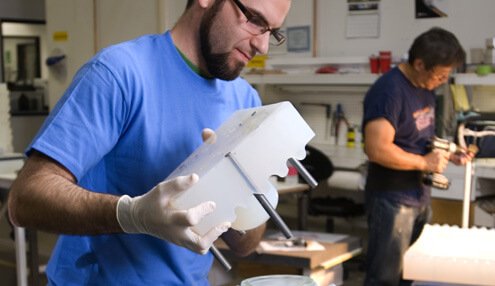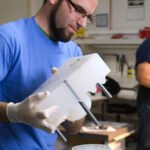Introduction
Welcome to our comprehensive guide on vacuum casting services. In this article, we will explore the world of vacuum casting and how it can be utilized to create high-quality prototypes. Whether you are an engineer, designer, or entrepreneur, understanding the process of vacuum casting can greatly benefit your product development journey. From its applications to the advantages it offers, we will cover it all. So, let’s dive in and explore the fascinating world of vacuum casting services!
Vacuum Casting Services: A Closer Look
Vacuum casting services are a crucial aspect of the rapid prototyping process. It involves the creation of high-quality prototypes using silicone molds and polyurethane resins. This technique is widely used across various industries, including automotive, aerospace, medical, and consumer goods. By utilizing vacuum casting services, manufacturers can efficiently produce functional prototypes that closely resemble the final product.
How Does Vacuum Casting Work?
The process of vacuum casting involves several steps that work together to create accurate and detailed prototypes. Let’s take a closer look at each of these steps:
Step 1: Master Pattern Creation
To begin the vacuum casting process, a master pattern is created using various methods such as 3D printing, CNC machining, or hand sculpting. This master pattern serves as the basis for the subsequent steps and should accurately represent the final product.
Step 2: Mold Creation
Once the master pattern is ready, a silicone mold is created around it. Silicone is an excellent material for molding due to its flexibility and durability. The master pattern is encased in the silicone mold, which will later be used to create multiple replicas.
Step 3: Mold Preparation
After the silicone mold has cured, it is prepared for the casting process. This involves carefully cutting the mold into two or more halves, depending on the complexity of the prototype. These mold halves will be later assembled to create a cavity for pouring the resin.
Step 4: Resin Casting
With the mold prepared, the next step is resin casting. Polyurethane resin, which exhibits excellent flow properties, is commonly used in vacuum casting. The resin is mixed with appropriate additives and poured into the mold cavity.
Step 5: Vacuum Chamber
Once the mold is filled with resin, it is placed in a vacuum chamber. The vacuum chamber removes any air bubbles trapped within the resin, ensuring a smooth and void-free casting. This step is crucial for achieving high-quality prototypes.
Step 6: Curing
After the vacuuming process, the mold is transferred to a curing chamber where the resin is allowed to cure and solidify. The curing time depends on the type of resin used and can vary from a few hours to overnight.
Step 7: Mold Removal
Once the resin has fully cured, the mold halves are separated, and the prototype is carefully removed. Any excess material or imperfections are trimmed, sanded, or polished to achieve the desired finish.
The Advantages of Vacuum Casting Services
Now that we have a good understanding of the vacuum casting process, let’s explore the advantages it offers:
1. Cost-Effective Prototyping
Vacuum casting provides a cost-effective solution for producing small to medium batch sizes of prototypes. Compared to traditional manufacturing methods, such as injection molding, vacuum casting offers a significantly lower tooling cost. This makes it an ideal choice for entrepreneurs and startups looking to develop and test their product ideas without breaking the bank.
2. Quick Turnaround Time
One of the key advantages of vacuum casting of vacuum casting services is the quick turnaround time it offers. With efficient mold preparation and resin curing processes, manufacturers can obtain functional prototypes within a relatively short timeframe. This accelerated timeline allows for faster iterations and product refinements, ultimately speeding up the overall product development cycle.
3. High-Quality Replicas
Vacuum casting services produce high-quality replicas that closely resemble the final product. The silicone molds used in the process capture intricate details, textures, and surface finishes, resulting in prototypes that are visually and functionally accurate. This level of detail is crucial for design validation, user testing, and investor presentations.
4. Material Variety
Another advantage of vacuum casting is the ability to work with a wide range of materials. Polyurethane resins come in various formulations, allowing manufacturers to choose materials that closely mimic the properties of the intended production materials. This versatility in material selection ensures that prototypes accurately reflect the performance and characteristics of the final product.
5. Complex Geometry
Vacuum casting is particularly well-suited for creating prototypes with complex geometries and undercuts. The flexible nature of silicone molds enables the replication of intricate shapes, thin walls, and internal cavities that would be challenging to achieve using traditional manufacturing methods. This opens up new design possibilities and facilitates the exploration of innovative product concepts.
Vacuum Casting Services: Applications
The applications of vacuum casting services span across multiple industries and sectors. Let’s explore some of the key areas where vacuum casting finds significant utility:
Automotive Industry
In the automotive industry, vacuum casting plays a crucial role in the prototyping and development of new vehicle components. From interior trim pieces to functional under-the-hood parts, vacuum casting allows automotive manufacturers to create prototypes that closely resemble the final product. This enables them to assess form, fit, and function before investing in expensive production tooling.
Aerospace Industry
The aerospace industry heavily relies on vacuum casting for rapid prototyping and the production of lightweight, high-performance components. By using vacuum casting, engineers can create complex parts with intricate geometries that meet stringent aerospace standards. The ability to produce functional prototypes quickly and accurately aids in testing and validation processes, ensuring that the final products perform as intended.
Medical Sector
Vacuum casting finds extensive applications in the medical sector, particularly in the development of medical devices and implants. From surgical instruments to prosthetics, vacuum casting allows manufacturers to produce prototypes that closely simulate the properties and functionality of the final products. This aids in evaluating ergonomics, usability, and compatibility before proceeding with large-scale production.
Consumer Goods
Vacuum casting is also widely employed in the consumer goods industry for the rapid development of prototypes and product iterations. Whether it’s consumer electronics, household appliances, or sporting goods, vacuum casting enables designers and manufacturers to create functional prototypes that closely resemble the final product. This facilitates market testing, feedback incorporation, and design optimization.
FAQs about Vacuum Casting Services
- Q: What are the primary materials used in vacuum casting services?
- A: Vacuum casting commonly utilizes polyurethane resins due to their excellent flow properties and versatility. These resins can mimic a wide range of production materials, providing prototypes with properties similar to the final product.
- Q: Is vacuum casting suitable for large-scale production?
- A: While vacuum casting is primarily used for prototyping and low-volume production, it may not be the most efficient choice for large-scale production. Injection molding is generally preferred for high-volume manufacturing due to its higher production speed and lower per-unit cost.
- Q: Can vacuum casting replicate intricate details and textures?
- A: Yes, vacuum casting is well-suited for replicating intricate details and textures. The flexible silicone molds used in the process can capture fine features, textures, and surface finishes



Business dicker I truly appreciate your technique of writing a blog. I added it to my bookmark site list and will
Tech to Trick I am truly thankful to the owner of this web site who has shared this fantastic piece of writing at at this place.
Your articles never fail to captivate me. Each one is a testament to your expertise and dedication to your craft. Thank you for sharing your wisdom with the world.
şile elektrikçi SEO çalışmaları, Google’da üst sıralara çıkmamıza yardımcı oldu. http://www.royalelektrik.com/
Techarp You’re so awesome! I don’t believe I have read a single thing like that before. So great to find someone with some original thoughts on this topic. Really.. thank you for starting this up. This website is something that is needed on the internet, someone with a little originality!
I’ve been following your blog for some time now, and I’m consistently blown away by the quality of your content. Your ability to tackle complex topics with ease is truly admirable.
Bahis tüyoları Google SEO stratejileri ile işimizi büyüttük. Ziyaretçi sayımız katlandı. http://royalelektrik.com/
Hi there to all, for the reason
I am truly thankful to the owner of this web site who has shared this fantastic piece of writing at at this place.
I like the efforts you have put in this, regards for all the great content.
Awesome! Its genuinely remarkable post, I have got much clear idea regarding from this post
I truly appreciate your technique of writing a blog. I added it to my bookmark site list and will
I very delighted to find this internet site on bing, just what I was searching for as well saved to fav
Su kaçağı tespiti kırmadan Su kaçağı tespitinde son teknoloji cihazlar kullanıyorlar, çok etkili bir hizmet. https://kansabook.com/ustaelektrikci
I truly appreciate your technique of writing a blog. I added it to my bookmark site list and will
dodb buzz Awesome! Its genuinely remarkable post, I have got much clear idea regarding from this post . dodb buzz
Üsküdar tesisat kaçak tespiti Rothenberger kaçak tespiti cihazı ile Üsküdar’daki su kaçağını bulduklarında çok memnun kaldım. https://socialmarkets.tech/blogs/1160/%C3%9Csk%C3%BCdar-Su-ka%C3%A7ak-tespiti
Malatya merkezi uydu sistemi Uyducu Malatya, acil uydu tamiri için çok hızlı yanıt verdi. https://sash.co.ke/read-blog/8690
Ümraniye süpürge filtre temizliği Evime kadar gelip cihazı aldılar, çok memnun kaldım. https://www.vokalayeadel.com/question/supurge-tamircisi/
Sportsurge Good post! We will be linking to this particularly great post on our site. Keep up the great writing
sulu süpürge bakımı Her seferinde kaliteli hizmet sunuyorlar. https://losguerrerosdeoracion.com/?dwqa-question=elektrikli-supurge-tamircisi
I wanted to take a moment to commend you on the outstanding quality of your blog. Your dedication to excellence is evident in every aspect of your writing. Truly impressive!
Hi Neat post There is a problem along with your website in internet explorer would test this IE still is the market chief and a good section of other folks will pass over your magnificent writing due to this problem
Nice blog here Also your site loads up fast What host are you using Can I get your affiliate link to your host I wish my web site loaded up as quickly as yours lol
Clochant I like the efforts you have put in this, regards for all the great content.
“I agree with your points, very insightful!”
Your blog is a constant source of inspiration for me. Your passion for your subject matter is palpable, and it’s clear that you pour your heart and soul into every post. Keep up the incredible work!
Og det beste? Alt pa naken tykk brunett mamma er gratis! Du kan nyte sa mye porno som i vil, uten the betale en krone. Dette er living room beste MILF-siden intended for deg som elsker vokseninnhold.
“Absolutely phenomenal work! The way you’ve broken down this complex topic while maintaining depth is impressive. Your expertise and research quality are evident throughout.”
“Mind = blown! 🌟 This is exactly the comprehensive breakdown I needed. Your expertise shines through in every paragraph. Thanks for sharing such well-researched content.”
Noodlemagazine very informative articles or reviews at this time.
Esenler su kaçağı tespiti Bahçelievler’deki evimizdeki su kaçağını buldular ve hemen onardılar. Çok profesyoneller. https://www.ulavu.com/ustaelektrikci